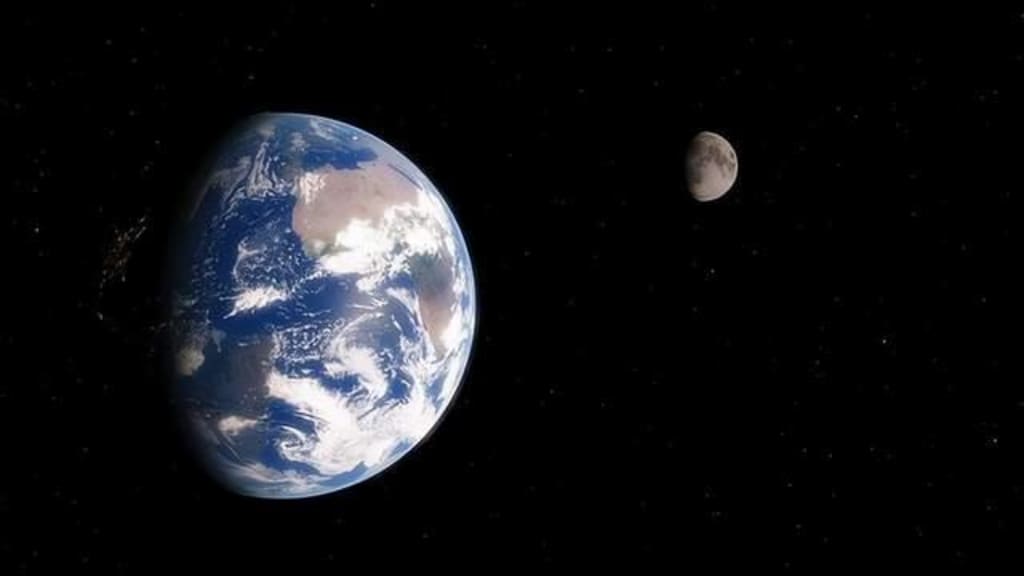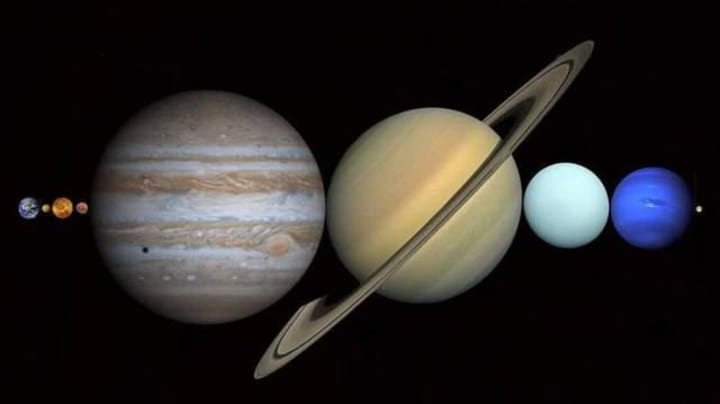
I believe that we all know that the universe we live in is very empty, but if you ask, how empty is the universe? It is estimated that many people will have no specific concept the universe is so empty that it is likely to be more than you can imagine. To illustrate how empty the universe is, we might as well start with the Earth and the Moon. Typically, we would imagine the Earth-Moon system as follows.
But in reality, this is not the case, because the average distance between the Earth and the Moon is about 380,000 km, while the radius of the Earth is about 6371 km, and the radius of the Moon is about 1737 km, so the real situation of the Earth and the Moon should look like this.
As you can see, there is much more space between the Earth and the Moon than expected, so what can be put down in this space?
Yes, just between the Earth and the Moon, you can put down all the planets in the solar system except for the Earth. After talking about the Earth-Moon system, let's take a look at the solar system, first on the map.
The outermost part of the 1st part of this picture is the orbit of Jupiter, the outermost part of the 2nd part is the orbit of Pluto and the Kuiper belt, and the outermost red orbit of the 3rd part belongs to the asteroid Sedna, whose perihelion is about 76 astronomical units from the Sun and aphelion is about 937 astronomical units from the Sun.
The outermost part of the 4th section is the Oort Cloud, whose inner edge is 2000 to 5000 astronomical units from the Sun, and whose outer edge is about 1 light-year away from the Sun, beyond which it is considered to have flown out of the solar system.
It is important to know that the Sun occupies about 99.86% of the mass of the entire solar system, and the majority of the remaining mass is occupied by the eight planets and their satellites, as for the small bodies orbiting in the solar system it is much more sparse than expected, even in the "dense" asteroid belt of small bodies, the average distance between each Even in the "dense" asteroid belt, the average distance between small bodies is also up to about 770,000 km (much farther than the Earth-Moon distance).
See here, I believe that you have a specific concept of the emptiness of the solar system, well, let's look at the Milky Way.
The stars in the Milky Way are very unevenly distributed, specifically, the farther away from the center of the galaxy, the lower the density of stars, in the core of the galaxy, the highest density of stars can reach 289,000 per cubic light year, while in the location of the 100-second gap from the center of the galaxy (about 326 light-years), the stellar density drops to 2.9 stars per cubic light year.
In the region where our solar system is located, the stellar density has dropped to 0.004 stars per cubic light year, and at the edge of the galaxy, the stellar density is as low as 0.0003 stars per cubic light year, which means that the average density of stars in the galaxy is about 0.006 stars per cubic light year, which means that there is about one star every 167 cubic light years, and the average distance between stars and The average distance between stars is about 5.5 light-years.

For the sake of understanding the emptiness of the Milky Way, let's assume that there are two stars as big as the Sun, and the distance between them is 5.5 light years, based on this if we shrink these two stars to the size of soccer, then after the same proportion of shrinkage, the distance between these two "footballs" is about 8223 km. kilometers.
Observations show that other galaxies in the universe are about as empty as the Milky Way, and more importantly, the distance between galaxies in the universe is often hundreds of thousands or millions of light years, and the vast space between galaxies is so sparse that it is almost a void.
In addition, there are many "cosmic voids" in the universe, in which the number of galaxies is very rare, or no galaxies at all.
These "holes" are usually very large, and some of them are even bigger than you can imagine, for example, in the direction of the constellation of Shepherd about 700 million light-years from Earth, there is a diameter of about 250 million light-years "Shepherd's Hollow", which spans about 0.26% of the entire observable universe.
The distribution of galaxies in the universe is already very sparse, the existence of the "cosmic hole" further increases the degree of the emptiness of the universe, and as mentioned above, the galaxies themselves are very empty, this series of circumstances superimposed, course, the universe will be ridiculously empty, and how ridiculous is it?
Theoretically, we only need to measure the volume and mass of the universe to calculate the matter density of the universe, but obviously, we cannot do such a thing, so we have to settle for the second best, to see what the matter density of the observable universe is.
At the macroscopic level, the matter of the observable universe is uniformly distributed in the whole, and since the volume of the observable universe is known, it is only necessary to measure the mass of a part of it to estimate the matter density of the entire observable universe. The mass of a proton.
What is this concept? Let's say there is a square box with a prism length of 1 meter, containing 6 protons, and now we enlarge the proton in the box to the size of a common glass marble (about 1.5 cm in diameter), then the prism length of this square box will be enlarged to about 9 billion kilometers in the same proportion, as a comparison, the average distance between Pluto and the Sun is only about 5.9 billion kilometers.
In a giant square box with a prism length of 9 billion kilometers, there would be only six glass marbles with a diameter of about 1.5 cm, and this would be considered the degree of the emptiness of the observable universe, how about, is it a little beyond your imagination?
It should be noted that the scientific community generally believes that the universe is composed of "ordinary matter", "dark matter" and "dark energy", as we have no idea about " dark matter" and "dark energy", we cannot be sure whether they exist or not, so the scope of this paper is limited to "ordinary matter" and does not include "dark matter" and "dark energy". "dark matter" and "dark energy" are not included.
Well, that's all for today, welcome to follow us and we will see you next time.
About the Creator
Fei Fei
Fantasy is the poet's wings, hypothesis is the ladder of science。






Comments
There are no comments for this story
Be the first to respond and start the conversation.